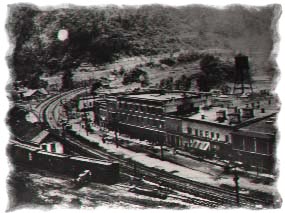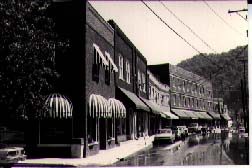 |
|
|
|
| Home | Town | History | People | Events |
| Media | Schools | Government | Links | Home |
| The Tug Valley | Historic Landmark | The Floods | The Movie | Mountain Culture | Mining Life |
| The Legacy | The Battle of Matewan | The Feud | Quest for Resources | More Coming Soon | More Coming Soon |
 A
young John L. Lewis had just taken office as President of the United Mine
Workers of America when, in January of 1920, he announced the campaign
in Bluefield, West Virginia: The UMWA would organize coal miners in the
southern Appalachians. Lewis knew coal operators would resist to the bitter
end, but that didn't matter. The miners wanted to organize; the UMWA had
to have their memberships; even coal operators from the midwest favored
the drive which might reduce the competitive edge the Southern Appalachian
coal mines enjoyed with non-union mines.
A
young John L. Lewis had just taken office as President of the United Mine
Workers of America when, in January of 1920, he announced the campaign
in Bluefield, West Virginia: The UMWA would organize coal miners in the
southern Appalachians. Lewis knew coal operators would resist to the bitter
end, but that didn't matter. The miners wanted to organize; the UMWA had
to have their memberships; even coal operators from the midwest favored
the drive which might reduce the competitive edge the Southern Appalachian
coal mines enjoyed with non-union mines.
Miners along the Tug Fork were ready; many had long wanted to join the miners union. Miners at Burnwell, three miles from Matewan, sent a delegation to the UMWA offices in Charleston, and they returned with a charter of a union local. The drive had begun. It quickly grew.
The coal operators resisted as strongly as expected; when a miner joined the union, he was immediately fired from his job. If he lived in a company-owned home -- as most did -- he was told to move out. If he didn't move out, gun-bearing Baldwin-Felts "detectives" evicted him and his family, setting his furniture out on the road. Despite that kind of opposition, miners by the hundreds along the Tug Fork joined the union. By May 15, 1920, three thousand Tug Fork miners had joined.
 Nowhere
was union activity greater that spring than in Matewan. There, the police
chief, Sid Hatfield, a former miner, and Mayor C. Testerman openly cooperated
with the drive and protected the miners as they held organizing meetings
in the town.
Nowhere
was union activity greater that spring than in Matewan. There, the police
chief, Sid Hatfield, a former miner, and Mayor C. Testerman openly cooperated
with the drive and protected the miners as they held organizing meetings
in the town.
Despite efforts by Hatfield to keep the Baldwin-Felts detectives away from Matewan, they came anyway. On May 19, 1920, thirteen detectives, including Baldwin-Felts president Thomas Felts, younger brothers Albert and Lee, arrived in Matewan to evict miners and their families from their homes in the Stone Mountain Mine camp.
 Nothing
angered miners more than "thugs" forcing women and little children from
their homes at gunpoint. Word of the evictions spread like wildfire. Angry
miners from Matewan and the surrounding area grabbed guns and rushed to
the town as the detectives evicted six more families in dismal rainy weather.
Hatfield led a group of miners to the Stone Mountain camp and tried to
stop the evictions, but the Felts brothers refused his plea. When the detectives
returned to Matewan that afternoon, having finished their jobs, Hatfield,
surrounded by armed miners, tried to arrest Al Felts for conducting the
evictions without proper Matewan authority. As he and Mayor Testerman glared
at Al Felts and the other detectives outside the railroad depot, someone
fired a shot, and the battle was on.
Nothing
angered miners more than "thugs" forcing women and little children from
their homes at gunpoint. Word of the evictions spread like wildfire. Angry
miners from Matewan and the surrounding area grabbed guns and rushed to
the town as the detectives evicted six more families in dismal rainy weather.
Hatfield led a group of miners to the Stone Mountain camp and tried to
stop the evictions, but the Felts brothers refused his plea. When the detectives
returned to Matewan that afternoon, having finished their jobs, Hatfield,
surrounded by armed miners, tried to arrest Al Felts for conducting the
evictions without proper Matewan authority. As he and Mayor Testerman glared
at Al Felts and the other detectives outside the railroad depot, someone
fired a shot, and the battle was on.
It lasted about a minute, but hundreds of shots were fired. Al Felts
and Testerman fell in the first volley. When it was over, seven detectives,
including both Al and Lee Felts, Mayor Testerman, and two miners were dead
or dying.
The battle made Sid Hatfield a folk hero for miners throughout the nation. Fifteen months later, the Baldwin-Felts detectives retaliated by killing Hatfield on the McDowell County courthouse steps at Welch, in a murder so brutal that it touched off an armed rebellion of 10,000 West Virginia coal miners in the largest insurrection this country has had since the Civil War.
FOR MORE ON THE BATTLE OF MATEWAN: Click Here
| Home | Town | History | People | Events |
| Media | Schools | Government | Links | Home |
